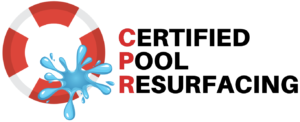Fiberglass Pool Resurfacing
What You Should Know About Pool Resurfacing
By Peter Gibson
Our Expert Specifying / Corrosion Engineer
The time has arrived to resurface your pool. Today, the pool owner has more choices. Historically, plaster was the standard method, but due to long-term performance advantages, pool owners are increasingly utilizing fiberglass.
It is important to bear in mind that plaster performs differently in new construction, compared to renovation. There are numerous problems with the use of plaster for resurfacing. Besides aesthetic issues, bonding (pop-offs) are a common occurrence.
These performance issues are in part as a result of the plaster being applied too thin. Common field observation thickness is 1/8″ There is not enough material mass, and consequently, spalling and erosion are often noticed. The typical period before deterioration sets in is three to five years. In a stringent economy, plaster quality is further compromised, to maintain a competitive advantage. Deterioration patterns are noticed much earlier.
In fact, plaster problems are so pervasive in the pool industry, that a technical body was formed to study the problems of plaster. Today, the National Plasters Council has got an ongoing study of plaster problems, to find the ways to overcome the defects.
Pool owners still ask the question, ‘why is plaster still used to resurface pools?’ The answer is that pool owners are not educated by the pool industry, that there are alternatives. Pool owners think that plaster is the only choice. In fact, fiberglass is now the defacto material used for commercial pools. The reason for this is, due to the high cost to refinish commercial pools, they want a material that has got a long service life, and will perform adequately over an extended period. Facility owners want to avoid ongoing costly maintenance.
A common question is what is the cost difference between plaster, and fiberglass. The question has not got any easier to answer, because each plaster company uses different techniques, and materials. Fiberglass materials are based on petro chemicals, and therefore, are more expensive then cementitious materials. Another reason for price variations between contractors, is the lack of standards. When fiberglass is applied, we follow the guidelines of consensus standards, which have been compiled by coatings societies.
Composite materials are widely used in the corrosion industry, because in a word, they are more corrosion resistant, than cementitious products.
Prices vary between plaster contractors, due to the following:
- thickness – different thicknesses are applied i.e., quantity of material
- hydrating agents
- Admixtures
- Modifiers
- Bonding agents
- Plaster quality (varies)
- Application specifications
- Contractor skill level
Due to the foregoing, it can be deduced that prices will vary between contractors. There is little price difference between high-end plaster applications, and fiberglass.
Unfortunately, for plaster companies, it is a very competitive business, so contractors are forced to cut corners, to secure work. Many only use very basic materials, with the subsequent problems. Most pool owners are lay persons, not familiar with these issues, and do not know what kind of job they will be getting. Consequently, they make a contractor selection based on price only, and do not consider material and application techniques.
The composite industry is a more sophisticated business. We provide the pool owner with product data sheets and consensus standards, which explains upfront exactly what work will be performed. This enhances the bidding process, as all contractors bid to the consensus standards. In this way, controlling the quality of the work and contractor skill level.
Composite materials are widely used throughout the world for industrial corrosion protection. They have a tremendous track record for durability. Today, polymeric materials are the materials for choice to prevent corrosion and not cementitious products.
###
Peter Gibson
Our Expert Specifying / Corrosion Engineer
Technical Affiliations:
SPI – Composites Institute
ACMA – American Composites Manufacturers Association
SSPC – Society for Protective Coatings
NACE – The Corrosion Society
Check out our San Diego California Fiberglass Swimming Pool Fact Sheet brochure.
For more information about Fiberglass from other pros in the industry, check out Aqua Magazine.
Fiberglass Pool Resurfacing

